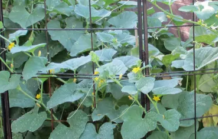Scott Eckert,
Harvey County
Extension Agent
Have you ever seen a tiny beaver? Me either, but I have seen damage to small branches of trees that look like a little bitty beaver chewed them off. This “little beaver” is called a Twig Girdler. Twig girders can be a problem in a wide variety of trees in our area. These include hickory, oak, linden, hackberry, apple, pecan, persimmon, poplar, elm, honeylocust, and some flowering fruit trees.
Twig girdlers attack elm and hickory as evidenced by fallen twigs up to three feet long. The beetle Oncideres Cingulata is most likely the culprit. This insect is distributed throughout the eastern United States from New England to Florida and as far west as Kansas and Arizona. The adults are long-horned beetles with grayish- brown body that is stout and cylindrical. The larva are also cylindrical with a small head and shiny integument. Larvae can be up to one inch in length and are light brown to brownish-gray.
Girdled twigs often remain on the tree until wind dislodges them. Large infestations can result in a high percentage of twigs being girdled. Though this may reduce the vigor and overall appearance of the tree, the overall effect on the tree’s health is not severe. However, the twigs are unsightly and do not fall all at once so clean-up is a drawn out process.
This beetle has a one-year life cycle. Late in the growing season, the female deposits eggs in small scars it has chewed through the bark and then chews a continuous notch around the twig, girdling it. The notch is cut below the site of egg deposition apparently because the larva is unable to complete development in the presence of large amounts of sap. Girdled twigs die and fall to the ground where the eggs hatch. Girdled twigs look like a beaver has worked on it only in miniature. The outside of the twig is smoothly cut but the center of the twig has a broken appearance. The larvae begin feeding on dead wood inside the twigs the following spring and continue through most of the summer. Pupation takes place inside the feeding cavity. Development is completed during August when the adult emerges to repeat the cycle.
Though the adults will feed on the bark of host twigs, damage is minimal until the female starts the girdling process.
Recommendations: Chemical control is impractical. Fallen twigs can be gathered and disposed of either in the fall or in the spring as this will destroy the larvae inside the twigs. Often, natural mortality is high due to excessive drying of fallen twigs or too many larvae per twig.




